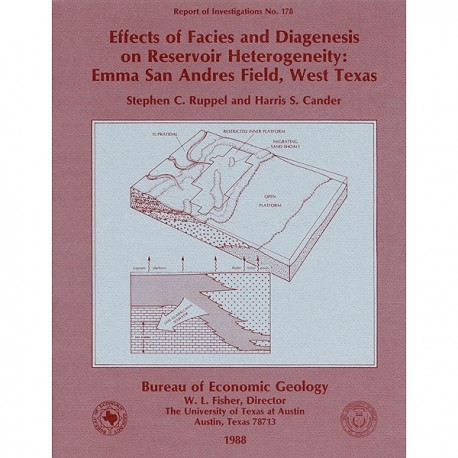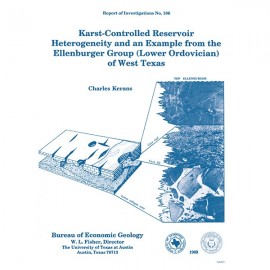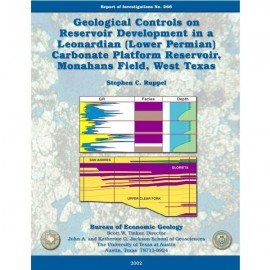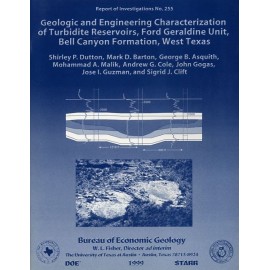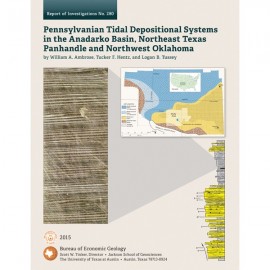Reports of Investigations
-
Books & Reports
- Reports of Investigations
- Guidebooks
- Udden Series
- Geological Circulars
- Down To Earth
- Atlases of Major Oil and Gas Reservoirs
- Texas Memorial Museum Publications
- Environmental Geologic Atlas of the Texas Coastal Zone
- Mineral Resource Circulars
- Other Reports
- Seminars and Workshops
- Handbooks
- Submerged Lands of Texas
- Symposia
- Annual Reports
- Open File Reports
-
Maps & Cross Sections
- Thematic Maps
- Miscellaneous Maps, Charts & Sections
- Geologic Atlas of Texas
- STATEMAP Project Maps
- Geologic Quadrangle Maps
- Cross Sections
- Highway Geology Map
- Energy and Mineral Resource Maps
- Shoreline Change and Other Posters
- Wilcox Group, East Texas, Geological / Hydrological Folios
- Bouguer Gravity Atlas of Texas
- River Basin Regional Studies
- Featured Maps
- Posters
- Teachers & the Public
-
Geological Society Publications
- Gulf Coast Association of Geological Societies
- Alabama Geological Society
- Austin Geological Society
- Corpus Christi Geological Society
- Houston Geological Society
- Lafayette Geological Society
- Mississippi Geological Society
- New Orleans Geological Society
- South Texas Geological Society
- GCS SEPM Publications
- Historic BEG & UT Series
Effects of Facies and Diagenesis on Reservoir Heterogeneity: Emma San Andres Field, West Texas
RI0178
For a downloadable, digital version: RI0178D.
RI0178. Effects of Facies and Diagenesis on Reservoir Heterogeneity: Emma San Andres Field, West Texas, by S. C. Ruppel and H. S. Cander. 67 p., 52 figs., 3 tables, 11 plates, 2 appendices, 1988. ISSN: 0082335X. Print.
To purchase this publication as a downloadable PDF, please order RI0178D.
ABSTRACT
Pervasively dolomitized, anhydritic carbonates of the upper San Andres Formation in the Emma field of West Texas constitute an upward-shallowing sequence of lithofacies representing four major depositional environments. Open Platform fusulinid packstone/wackestone and burrowed wackestone form the base of the sequence. These deposits, which accumulated in a shallow-water, normal marine setting, contain moldic and intercrystalline porosity and constitute the lower of two major porosity intervals in the reservoir section. Overlying deposits consist of interbedded skeletal grainstone (Shoal) and burrowed mudstone and skeletal wackestone (Restricted Inner Platform). Skeletal grainstone, which accumulated in migrating sand shoals in a shallow-water, inner-platform setting, contains well-developed intergranular porosity and forms the upper, more permeable reservoir interval in the field. Associated, much less porous mudstone and wackestone were deposited between shoal areas in relatively quiet water. The top of the San Andres is characterized by supratidal pisolite grainstone, cryptalgal mudstone, and interbedded fine-grained siliciclastics that contain fenestral fabric, tepees, and desiccation structures indicative of deposition under conditions of frequent subaerial exposure.
Lithification of the Emma San Andres reservoir resulted primarily from early, pervasive dolomitization. Two major episodes of replacement dolomitization occurred. Red-luminescent, matrix-replacive dolomite appears only in a siliciclastic-rich interval in the middle of the reservoir section. Petrographic and stable isotope data suggest that this earliest dolomite (Dolomite 1) formed contemporaneously with deposition from seawater having near-normal salinity during late San Andres time (middle Guadalupian). Alternatively, formation of this dolomite may have been associated with subaerial exposure during a major regional fall in relative sea level. Pervasive, brown-luminescent Dolomite 2 constitutes the bulk (>90 percent) of the dolomite in the sequence. …Dolomite 2 formed from seawater brines evaporated to near gypsum saturation. Trace element and strontium isotope data imply that dolomitizing fluids had a downward component of flow through the section. Strontium isotopes also constrain the timing of this diagenetic event as late Guadalupian in age and indicate that the dolomitizing fluids were derived from late Guadalupian seawater. Trace element and strontium isotope compositions of dolomite reflect varying degrees of intraformational rock/water interaction between late Guadalupian seawater-derived brines and siliciclastic beds within the San Andres
Petrographic relationships indicate that most anhydrite was emplaced after dolomitization of the section. Strontium and sulfur isotope data are consistent with this interpretation and indicate that sulfates precipitated from fluids having an origin similar to that of most dolomite. Minor leaching of sulfate locally increased reservoir porosity. Early lithification by stable replacement dolomite resulted in preservation and retention of most primary porosity. Thus, porosity distribution in the reservoir is controlled mainly by variations in original depositional texture and fabric. The upper, skeletal grainstone (Shoal) porosity interval contains significant reservoir porosity well off the axis of the field structure. Comparison of production data with facies maps suggests that 85 percent of the oil recovered to date from the reservoir has come from the upper porosity interval. Calculations indicate, however, that as much as 8 MMbbl of unrecovered mobile oil remains in this zone. The lower, fusulinid packstone/wackestone (Open Platform) porosity interval may contain an additional 7 MMbbl of recoverable mobile oil.
Keywords: diagenesis, dolomite, Emma field, facies, geochemistry, isotopes, Permian, reservoir heterogeneity, San Andres, West Texas
CONTENTS
Abstract
Introduction
PART I. FACIES AND DEPOSITIONAL SETTING
Regional Setting
Structural and Stratigraphic Setting
Fades and Depositional Environments
Open Platform
Lithofacies
Paleoenvironment
Shoal
Lithofacies
Paleoenvironment
Restricted Inner Platform
Lithofacies
Paleoenvironment
Supratidal
Lithofacies
Paleoenvironment
Paleogeography and Depositional History
PART II. DIAGENESIS AND GEOCHEMISTRY
Introduction
Methods
Petrography
Dolomite
Anhydrite
Other Minerals
Geochemistry
Major, Minor, and Trace Element Data
Strontium Isotopes
Stable Isotopes
Carbon and oxygen
Sulfur
Origin and Timing of Diagenesis
Dolomite 1
Dolomite 2
Dolomites 3 and 4
Anhydrite
Calcite
Paragenetic Sequence
PART III. RESERVOIR GEOLOGY
Porosity and Permeability
Lower Porosity Interval (Open Platform Deposits)
Upper Porosity Interval (Shoal Facies)
Porosity Evolution during Diagenesis
Distribution of Porous Facies
Production Data
Remaining Mobile Oil
Implications for Future Hydrocarbon Production
Conclusions
Acknowledgments
References
Appendices
1. Trace Element Data
2. Isotope Data
Figures
1. Comparison of hydrocarbon production in the Permian Basin of West Texas and New Mexico by age of reservoir
2. Map of West Texas and eastern New Mexico showing major subsurface geologic features, University lands, distribution of San Andres/Grayburg oil fields, and location of the Emma field
3. Structural cross section (A-A') across the Central Basin Platform showing draping of Permian deposits over faulted and folded pre-Permian rocks
4. Stratigraphic cross section (B-B') of middle and upper Permian strata along the western margin of the Central Basin
5. General Upper Permian stratigraphy and vertical fades sequence in the upper San Andres Formation, Emma field area
6. Structure-contour map, Emma field area
7. Cross section (C-C'} through the Emma field depicting vertical and horizontal extents of upper San Andres lithofacies
8. Core photograph of fusulinid packstone/wackestone lithofacies
9. Photomicrographs illustrating variable preservation of fusulinids in the fusulinid packstone/wackestone lithofacies
10. Core photographs of burrowed wackestone lithofacies (Open Platform)
11. Photomicrograph of poikilotopic anhydrite in fusulinid packstone/wackestone
12. Photomicrograph of skeletal grainstone (Shoal) illustrating the dasyclad alga Mizzia(?)
13. Cross section (D-D') illustrating the distribution of Shoal (skeletal grainstone) and Open Platform (fusulinid packstone/wackestone) fades across the Emma field area
14. Thickness and distribution of porous skeletal grainstone (Shoal)
15. Core photograph showing supratidal crusts in fenestral mudstone of the Restricted Inner Platform
16. Core photograph of pisolitic grainstone (Supratidal)
17. Core photograph of pisolitic, fenestrally laminated mudstone-wackestone (Supratidal)
18. Core photograph of mud-cracked, algally laminated mudstone (Supratidal)
19. Core photograph of cryptalgal mudstone containing fine-grained siliciclastic debris
20. lsopach map of the X-A interval in the Emma field area
21. lsopach map of the Z marker in the Emma field area
22. Paleoenvironmental reconstruction of the Emma field area during late San Andres time
23. SEM photomicrograph showing euhedral inclusions of dolomite rhombs within an anhydrite nodule
24. Photomicrograph showing inclusions of dolomite in poikilotopic anhydrite
25. Photomicrograph depicting anhydrite replacement of dolomite
26. Photomicrograph showing partial replacement of dolomitized skeletal structure by anhydrite
27. Variation of Fe concentration with depth in the upper San Andres section of the ARCO Emma Cowden No. 99 core
28. Variation of Fe concentration with depth in the upper San Andres section of the ARCO Emma San Andres Unit No. 9-7 core
29. Scattergram showing variation in Fe and Mn concentration among dolomite types
30. Variation of 87Sr/86Sr with depth in the ARCO Emma Cowden No. 99 core
31. Secular variation in 87Sr/86Sr during the Phanerozoic and Permian
32. Carbon and oxygen isotope data from the upper San Andres Formation, Emma field
33. Distribution of carbon and oxygen isotope values with depth in the ARCO Emma Cowden No. 99 core
34. Distribution of carbon and oxygen isotope values with depth in the ARCO Emma San Andres Unit No. 9-7 core
35. Distribution of carbon and oxygen isotope values with depth in the ARCO Emma San Andres Unit No. 10-9 core
36. Vertical distribution of 6345 in the ARCO Emma Cowden No. 99 core
37. Secular variation in seawater 634S values
38. Proposed alternative models of formation of Dolomite 1
39. Proposed model of formation of Dolomite 2
40. Histograms of permeability and porosity values recorded in the lower porosity zone (Open Platform)
41. SEM photomicrograph showing euhedral dolomite cement lining margins of small mold
42. SEM photomicrograph of leached dolomite rhomb center
43. Photomicrograph of fusulinid wackestone showing moldic and intercrystalline porosity
44. Core photograph of light-colored, vertical zones in Open Platform deposits that contain higher than average intercrystalline porosity
45. Histograms of permeability and porosity values recorded for the upper porosity zone (Shoal)
46. Cross plot of porosity and permeability data from Shoal deposits taken from core analysis
47. Map of net pay in the lower porosity interval (Open Platform)
48. Map of total production prior to onset of waterflooding (May 1965)
49. Map of initial oil production volumes (1937-1941)
50. Contour map of water-cut values for January 1972
51. Contour map of total oil production from the Emma San Andres reservoir after May 1965 (onset of waterflooding) to January 1986
52. Contour map of total oil production from the Emma San Andres reservoir as of January 1986
Tables
1. Petrographic and geochemical data, San Andres dolomites
2. Sulfur isotope data, Emma San Andres reservoir
3. Volumetrics, Emma San Andres reservoir
Plates
1. Paired plane-light and cathodoluminescence color photomicrographs of Open Platform fusulinid packstone
2. Paired plane-light and cathodoluminescence color photomicrographs of matrix-replacive, red-luminescent Dolomite 1
3. Paired plane-light and cathodoluminescence color photomicrographs showing three types of dolomite present in the upper San Andres Formation, Emma field area
4. Paired plane-light and cathodoluminescence color photomicrographs showing inclusion-rich, matrix-replacive Dolomite 1 at the X marker
5. Paired plane-light and cathodoluminescence color photomicrographs showing crosscutting relationships that constrain the relative timing of three of the dolomite types present in the Emma San Andres reservoir
6. Color photomicrograph showing leached dolomite rhomb along the margin of an anhydrite nodule in fusulinid packstone (Open Platform)
7. Color photomicrograph showing leached anhydrite in fusulinid mold in fusulinid wackestone
8. Color photomicrograph showing replacement of anhydrite by calcite
9. Color photomicrograph illustrating the abundant intercrystalline porosity in the upper, skeletal grainstone (Shoal) porosity interval
10. Color photomicrograph illustrating intergranular and intragranular pore space in the upper, skeletal grainstone (Shoal) porosity interval
11. Color photomicrograph showing enhancement of porosity in skeletal packstone(?) of the upper porosity interval (Shoal)
Citation
Ruppel, S. C., and Cander, H. S., 1988, Effects of Facies and Diagenesis on Reservoir Heterogeneity: Emma San Andres Field, West Texas: The University of Texas at Austin, Bureau of Economic Geology, Report of Investigations No. 178, 67 p.
